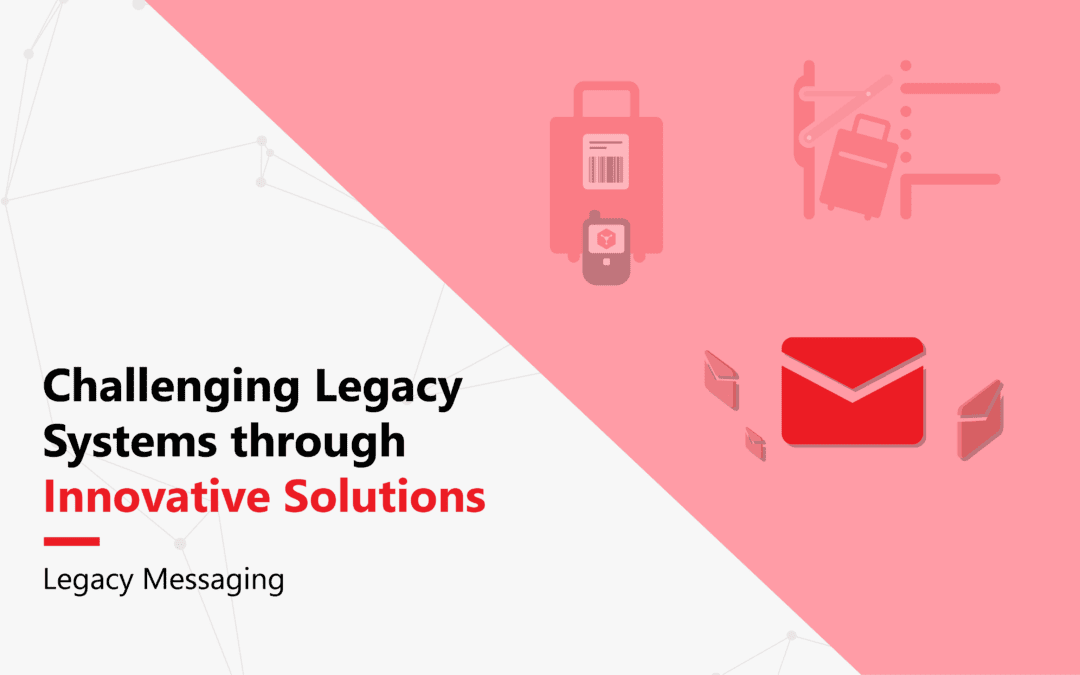In an increasingly interconnected world where air travel is an essential part of our lives, the air transport industry plays a vital role in the efficient and safe handling of passengers and bags.
However, our industry faces many challenges which hinder operational efficiency and passenger satisfaction. A primary culprit behind these challenges is the prevalence of legacy systems – outdated technologies and infrastructure that have become deeply ingrained within the industry over the years. Once considered cutting-edge solutions, these legacy systems are now bottlenecks that make any forward motion towards innovation difficult. Even with the technology infrastructure at our disposal today, from mobility and apps to secure transactions, vision systems, and data automation technology, our industry is still clinging onto these legacy systems that are years past their prime.
Legacy Systems are Holding the Industry Back
The continued reliance on legacy systems poses many challenges including inefficiencies in baggage handling, outdated passenger services systems, and limited data integration. These systems are often unable to adapt to the evolving demands of today’s travelers, leading to delays, mishandled baggage, compromised security, and a subpar passenger experience.
Furthermore, many legacy systems are siloed in nature resulting in disconnected information flows across airports and airlines. This lack of data integration inhibits effective communication, collaboration, and data sharing, which are critical components for achieving streamlined operations. While the COVID-19 pandemic forced airports and airlines to pivot their operations and strategies, there is still much work to do.
So, what can be done to loosen the tight grasp that the industry is holding onto these legacy systems in order to modernize the air transport industry?
This blog series will shed light on the prevailing issues within the industry and highlight how Brock Solutions and other key industry players are pioneering innovative solutions to transform airports and airlines. By leveraging modern, cutting-edge technologies and a forward-thinking approach, we are challenging the status-quo and paving the way for a new era of efficiency, passenger satisfaction, and baggage clarity for the air transport industry.
With that being said, let’s begin with legacy messaging standards.
Legacy Messaging
In 2022, 42% of mishandled bags were classified as transfer bags, according to the 2023 Baggage IT Insights report. IATA estimates approximately 15% of these were caused by missing baggage information. While it may not seem like a lot, this has an estimated cost impact of over US$150 million per year.
The existing messaging standards, established in 1985, lack a seamless approach to facilitate integration and innovation in baggage systems. They do not have the ability to handle the data quality and quantity available to us today, thus resulting in missing baggage information. These outdated messaging standards include Type B messaging, which the industry still heavily relies on today.
Type B messages are less flexible compared to modern messaging as they follow a specific format and protocol which are limited to the size and complexity of data that can be transmitted in a single message. They don’t support real-time data exchange either, as messages are exchanged in predefined intervals or scheduled periods. Most frustratingly, the cost of Type B messaging is only rising making it unsustainable for some organizations.
The New Airline Industry Data Model
The Baggage Information Exchange Subgroup (BIX), a working group created by IATA and which Brock Solutions is an active member of, is responsible for developing the standards and processes related to baggage messaging standards. The ultimate goal of the BIX subgroup is to lead the transition away from current legacy messaging practices and promote the adoption of more modern standards.
As a result of this subgroup, a modern alternative for legacy Type B messages is the Airline Industry Data Model (AIDM). The aim of AIDM is to become a single point of access for storing structured information such as industry-agreed vocabulary and business requirements. There are several benefits to this new model, including:
- Improvement in data quality with the adoptions of XML
- Share information not possible with Type B messaging (e.g., photos)
- Reliable parsing which reduces misinterpreted messages
These benefits ultimately lead to fewer mishandled bags and lower associated costs. However, even though the industry recognizes the need to modernize communication protocols, many airlines are forced to continue relying on Type B messaging due to infrastructure and operational constraints. Integrations are often cost prohibitive and require significant know how on various protocols and ongoing support needs.
That’s where Brock Solutions’ SmartConnect comes into play.
SmartConnect
SmartConnect is a powerful message broker that interprets, manipulates, and routes messages between systems based on user-defined filters and business rules. It acts as a central messaging hub to interface with each system and relay messages between them, maximizing integration while reducing the complexity of the overall messaging architecture.
SmartConnect is designed to bridge the gap between legacy and modern messaging systems. It can process messages in any format, from any system, and we specialize in developing new messaging interfaces so new supported formats can be easily added. If your organization is still relying on Type B messaging, reach out to us to learn how we can help modernize your messaging systems.
In part two of our Challenging Legacy Systems blog, we dive deep into the history of bag tags, their evolution throughout the years, and the key industry players that are revolutionizing the future of bag tags. We then discuss the rising phenomenon of travelers opting for personal trackers to monitor their bags, highlighting the potential for airports and airlines to harness this data for an enriched tracking system and passenger experience. If you don’t already, follow us on LinkedIn and be part of the conversation shaping the future of baggage clarity and excellence!

